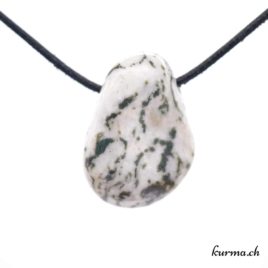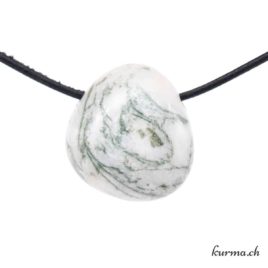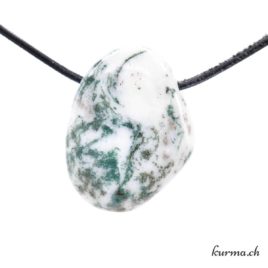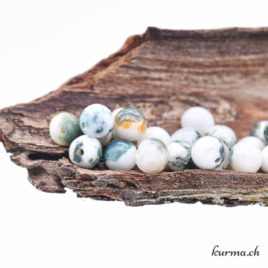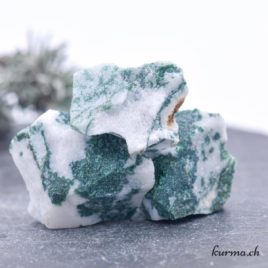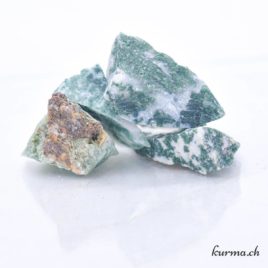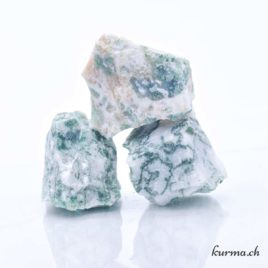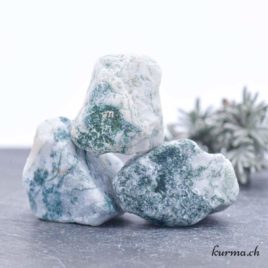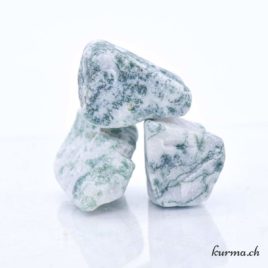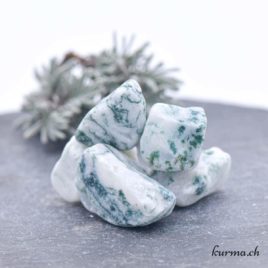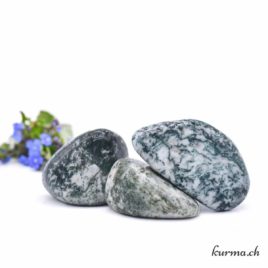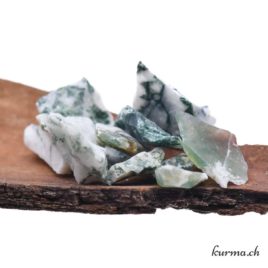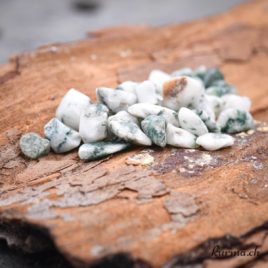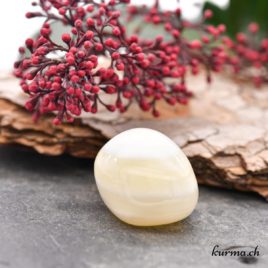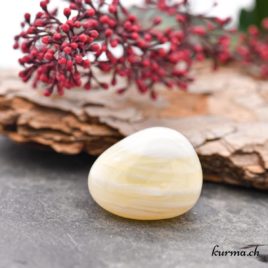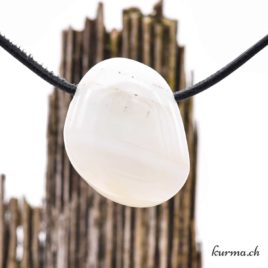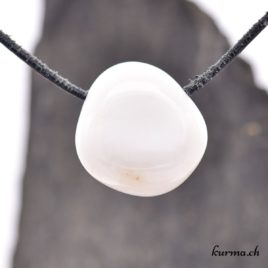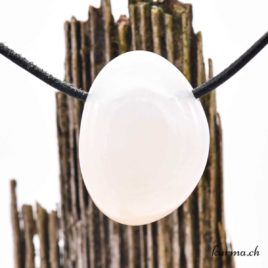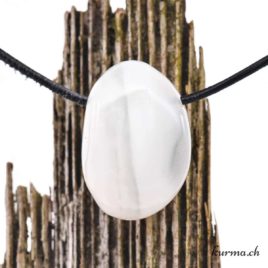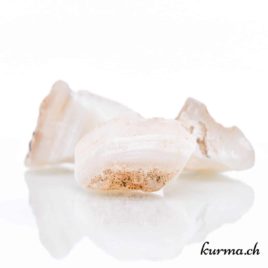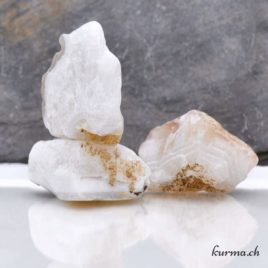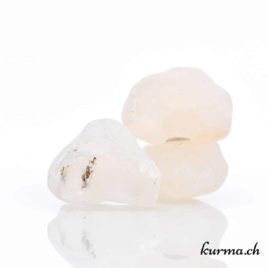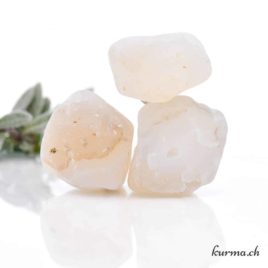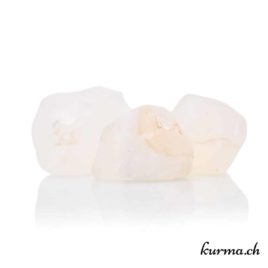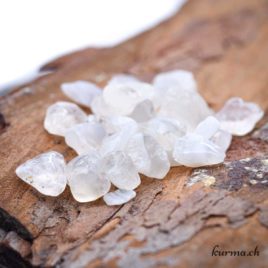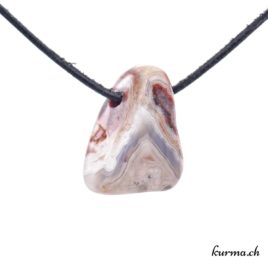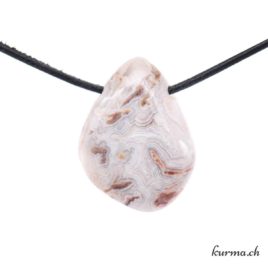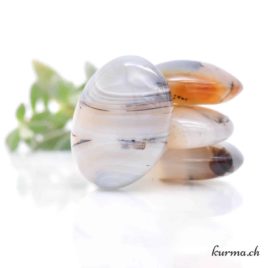Whitesemi-precious stones
Our selection of white gemstones includes a wide range of stones in minerals that are matte or brilliant, transparent or opaque, lighter and darker.
Stones, pearls and jewelry: below you'll find the astonishing diversity of perceptions of white around the world, its symbols and benefits in lithotherapy, as well as an account of its mineralogy.
Jewelry Stone pendants Agate Pendant Ammonite Pendant Aragonite Pendant Barite Pendant Petrified wood Pendant Chalcedony Pendant Cinnabar Pendant Rock crystal Pendant Gabbro Pendant Garnet Pendant Hiddenite Pendant Hornblende Pendant Howlite Pendant Jasper K2 Pendant Jasper Pendant Polychrome jasper Pendant Red Jasper Pendant White Labradorite Pendant Magnesite Pendant Marble Pendant Nellite Pendant Obsidian Pendant Onyx Pendant Opal Pendant Orthosis Pendant Moonstone Pendant Pietersite Pendant Pinolite Pendant Quartz Actinolite Pendant Quartz girasol Pendant Hematoid quartz Pendant Quartz lodolite Pendant Rutile Quartz Pendant Sulfur Quartz Pendant Quartz Tourmaline Pendant Rhyolite Pendant Sardonyx Pendant Scolecite Pendant Selenite Pendant Tiffany stone Pendant Tourmaline Pendant Pink Tourmaline Pendant
Stone bracelet Tree Agate Bracelet Crazy Lace Agate Bracelet Dendritic agate bracelet Botswana Agate Bracelet Mousse agate bracelet Rock crystal bracelet Children's bracelet Men's bracelet Howlite bracelet Jade bracelet Jasper bracelet Jasper Picasso bracelet Polychrome Jasper Bracelet Labradorite bracelet White Labradorite bracelet Magnesite bracelet Mother-of-Pearl Bracelet Tiger eye bracelet Onyx bracelet Opal bracelet Moonstone bracelet Rose Quartz bracelet Quartz Tourmaline Bracelet Tourmaline Bracelet
Cabochons Gifts Assortments
Pebbles for lithotherapy Sacred geometry Stone ball Stone heart Stone flower of life The "Merkaba" tetrahedral star Platonic solids
Lamps and candleholders Stone candlesticks Stone lamp
Semi-precious stone menhirs Agate menhir
Yoni eggs Agate eggs Rock crystal eggs
Pendulum Stone clock
Beads Shape Rounds
Beads from A to Z Agate beads Rock crystal pearls Howlite pearls Jasper beads Labradorite beads Magnesite beads Mookaïte beads Mother-of-pearl beads Obsidian pearls Opal beads Moonstone beads Tourmaline quartz beads Silicon pearls
Rough pocket stones Agate Brute Raw magnesite Rough Moonstone Raw selenite
Massage stones Stone massage stick Gua Sha
Stones and minerals from A to Z Agate Tree agate White agate Agate crazy lace Dendritic agate Botswana Agate Moss agate Aquamarine Ammonite Apophyllite Aragonite Aurichalcite Azurite Baryte Petrified wood Chalcedony Calcite White calcite Chrysocolla Cinnabar Rock crystal Orbicular diorite Dolomite Eudialyte Feldspar Gabbro Granite Graphite Garnet Hessonite garnet Herkimer Hiddenite Hornblende Howlite Jade Jasper Dalmatian Jasper Jasper K2 Polychrome jasper Red jasper Labradorite White Labradorite Lazulite Magnesite Malachite Marble Mookaïte Mother-of-pearl Nellite Obsidian Obsidian snowflake Tiger's eye Onyx Opale Dendritic opal Orthose Pargasite Moonstone White moonstone Grey or brown moonstone Pink moonstone Piétersite Pinolite Pyrite Quartz Actinolite Ghost quartz Girasol quartz Hematoid quartz Quartz lodolite Pink quartz Rutile quartz Sulfurous quartz Tourmaline quartz Rhyolite Rubellite Sardonyx Scolecite Selenite Shiva Lingam Flint Spinelle Spodumene Stilbite Tiffany stone Tourmaline Pink tourmaline Wollastonite
Stones Minerals Natural aquamarine Natural apophyllite Apophyllitele Natural aurichalcite Natural chrysocolla Natural rock crystal Natural eudialyte Natural Herkimer Natural Lazulite Natural Spinel Natural stilbite
Orgonite stones Rolled stones for lithotherapy Rolled agate Rolled barite Rolled calcite Rolled rock crystal Rolled orbicular diorite Rolled hiddenite Rolled howlite Rolled jasper Rolled white Labradorite Rolled magnesite Rolled marble Rolled obsidian Rolled opal Rolled pinolite Rolled selenite Rolled spodumene
Purification Flowers of life and sacred symbols Tree of Life Other Fleur de Vie
Stainless steel Acrylic Silver Wood Bronze Kraft cardboard Ceramics Cotton Leather Copper Elastic Epoxy Jute Brass Silver Brass Golden Brass Metal Mother-of-pearl Nylon Waxed nylon Organza Orgonite Bones Pierre Plastic Polyester Pink quartz Resin Rudraksha Satin Salt Leatherette Silk Suede lining Terracotta Velvet Glass
7 chakras Abalone Adamite Aegirine Agate Apricot agate Tree agate White agate Agate Carnelian Agate Crasy Lace Agate Crazy Lace Water agate Fire agate Dendritic agate Botswana Agate Agate flower Agate geode Agate grappe Moss agate Pink moss agate Orbicular agate Snakeskin agate Red agate Agate turitelle Zebra agate Aquamarine Albite Amazonite Amber Amethyst Rough amethyst Heated amethyst Druze amethyst Ametrine Ammonite Ancestralite Andalusite Angelite Anhydrite Anthophyllite Apatite Blue apatite Green apatite Aplite Apophyllite Aragonite Blue aragonite Slate Astrophyllite Atlantasite Augite Auralite Aurichalcite Aventurine Blue aventurine Aventurine orange Red aventurine Green aventurine Azurite Azurite Malachite Baryte Barite Basalt Beryl Biotite Blende Petrified wood Brazilianite Bronzite Bryozoaire Buddstone Cacoxenite Chalcedony Blue chalcedony Chalcedony ocean Green chalcedony Green chalcedony Calcite Apricot calcite White calcite Blue calcite Yellow calcite Optical calcite Orange calcite Pink calcite Red calcite Green calcite Cavansite Célestine Chalcopyrite Coal Charoïte Lime Chiastolite Chrysocolla Chrysopale Chrysoprase Chrysotile Cinnabar Cintamani Citrine Copal Coprolite Corail Fossilized coral Corundum Carnelian Covelline Fossil crinoids Rock crystal Copper Cuprite Cyanite Shark tooth Diopside Dioptase Orbicular diorite Disthène Dolomite Dravite Dumortierite Eilat stone Eldarite Kambaba Emerald Enstatite Epidote Eudialyte Feldspar Fluorite Rainbow Fluorite Blue fluorite Brown fluorite Yellow fluorite Lavender fluorite Green fluorite Violet fluorite Franklinite Fuchsite Fulgurite Gabbro Galaxite Galena Gedrite Gem Silica Agate geode Goethite Goshenite Granite Graphite Garnet Coarse garnet Hessonite garnet Pyrope garnet - Almandin Rhodolite garnet Tsavorite garnet Sandstone Gypsum Halite Heliodore Heliotrope Hematite Hemimorphite Herkimer Heulandite Hiddenite Hilutitis Hornblende Howlite Hyacinthe Hypersthene Iolite Jade African jade Burmese jade Chinese jade Canadian Jade Nephrite jade Black jade Jadeite Jadeite lavender Green jadeite Jais Jasper Red rainbow jasper Rainbow Jasper Bumblebee jasper Breccia jasper Chalcedony Jasper Dalmatian jasper Fossil jasper Yellow Jasper Jasper K2 Kambaba Jasper Leopard jasper Mookaïte Jasper Landscape jasper Picasso Jasper Polychrome jasper Red jasper Dragon's blood jasper Snake jasper Turitelle jasper Zebra jasper Kimberlite Kunzite Labradorite White Labradorite Lapis lazuli Larimar Larvikite Washing machine Lazulite Leopardite Lepidocrocite Lepidolite Lizardite Luxullianite Magnesite Magnetite Malachite Manganocalcite Marble Fossil marble Marcasite Mariposite Menalitis Merlinite Meteorite Mica Moldavite Mookaïte Morganite Muscovite Mother-of-pearl Nellite Nephritis Nickéline Nunderite Nuummite Obsidian Mahogany obsidian Rainbow obsidian Silver obsidian Golden obsidian Obsidian snowflake Obsidian lamella Obsidian Apache tear Huichol Manta obsidian Black obsidian Obsidian celestial eye Oeil-de-boeuf Hawkeye Horseshoe Tiger's eye Oncolite Oncolith Onyx Black onyx Green onyx Oolite Opale White opal Boulder opal Opale cappuccino Fire opal Dendritic opal Andes Opal Honduran opal Yellow opal Moss opal Black opal Pink opal Green opal Opaline Orthoceras Orthose Fossilized dinosaur bone Pargasite Peridot Petalite Phosphosiderite Piemontite Bluestones of Stonehenge Moonstone White moonstone Grey moonstone Black moonstone Peach moonstone Fairy Stone Sunstone Pietersite Pinolite Plagioclase Porphyry Prasem Prasiolite Prehnite Psilomelane Purpurite Pyrite Pyrophyllite Quartz Quartz actinolite White quartz Blue quartz Shaman quartz Lemon quartz River quartz Dendritic quartz Ghost quartz Strawberry quartz Smoky quartz Girasol quartz Grey quartz Hematoid quartz Lavender quartz Quartz lodolite Quartz Morion Cat's-eye quartz Peach quartz Quartz prase Pink quartz Rutile quartz Solar quartz Sulfurous quartz Tourmaline quartz Rhodochrosite Rhodonite Rhyolite Rhyolite leopard Rhyolite liesegang Green rhyolite Golden river Rose des sables Rubellite Ruby Ruby Fuchsite Zoïsite ruby Sapphire Blue sapphire Yellow sapphire Sardonyx Scapolite Scolecite Salt Selenite Septaria Seraphinite Serpentine Serpentine Chyta Serpentine Clinochlore Shattuckite Shiva Lingam Shungite Siberite Siderite Flint Silicon Smaragdite Smithsonite Sodalite Spectacularity Spectrolite Sphalerite Sphene Spiderweb stone Spinelle Spodumene Staurolite Soapstone Stichtite Stilbite Stromatolite Sugilite Super Seven Tanzanite Tectite Tectite cintamani Tenorite Thulite Tiffany stone Titanite Topaz Blue topaz Imperial topaz Yellow topaz Tourmaline Blue tourmaline Brown tourmaline Watermelon tourmaline Multicolored tourmaline Multicolored tourmaline Black tourmaline Pink tourmaline Green tourmaline Violet tourmaline Travertine Triplite Turquoise Turquoise (synth) Unakite Vanadinite Variscitis Verdelite Verdite Libyan glass Vesuvianite Vulcanite Wagnerite Wollastonite Wulfenite Wurtzite Yooperlite Zincite Zircon Zoïsite
Stone with clasp Pierced stone
Brilliant Gross Diamanté Mate Polished
Argus Atlantis Builder Stick Ball Gross Gross rounded Crude in pieces Bullet with tank Square Mushroom Heart Cone Conical Crystallized Cube Cylinder Décagone Disc Dodecahedron Dome Radiance Egyptian Tetrahedral star Veneer Leaf Fleur Roller Drop Hexagon Isis Kito Lingam mesh2 Merkaba Nuggets Octahedron Octagon Osiris Oval Palm Rolled stone Point Polis Pyramid Round Washer Roulée Sephoroton Sphere Elongated sphere Spiral Indicator Tetrahedron Twisted Triangle Venus
With facets Without facets
XXXS XXXXL XXXXXL XXXL XXL XL L M S XS XXS Mini
Batch S-M M-L One size 0.2mm 0.25mm 0.3mm 0.35mm 0.38mm 0.4mm 0.45mm 0.46mm 0.5mm 0.6mm 0.61mm 0.7mm 0.75mm 0.76mm 0.8mm 0.91mm 1mm 1.6cm 2cm 3cm 3.5mm 3.7mm 4mm 4cm 4.5mm 5mm 5cm 5x5cm 5.5mm 6cm 6mm 6.5mm 7x9cm 7x8cm 7cm 7mm 7.5mm 8-9cm 8x10cm 8x8cm 8cm 8mm 8.5mm 9mm 9-10cm 9cm 9.5mm 10x11cm 10mm 10-11cm 10x10cm 10x14cm 10-12cm 10cm 10.5mm 11mm 11cm 11.5mm 12-13cm 12x17cm 12x15cm 12mm 12-15cm 12cm 13cm 13mm 14cm 14x20cm 14mm 15-16cm 15mm 15cm 15x12cm 16mm 16cm 16-17 16.5mm 17mm 17cm 17-18mm 17.5 17.5mm 18mm 18cm 19x13cm 19cm 19mm 19.5mm 20x30cm 20mm 20cm 21mm 21cm 22mm 22cm 23mm 24mm 25cm 25mm 26mm 28mm 29mm 30cm 32cm 32-33cm 34cm 35mm 36cm 38cm 40cm 42cm 43-44cm 45mm 46cm 50-52cm 50mm 53cm 54cm 57cm 60-62cm 70cm 70mm 90mm
0.5mm 0.7mm 1mm 1.5mm 2mm 2.3mm 2.4mm 2.5mm 2.6mm 2.8mm 3x2mm 3mm 3.4mm 3.5mm 3.8mm 4mm 4x3mm 4.2mm 4.5mm 4.5nn 4.5cm 5-10mm 5mm 5x7mm 5.5mm 5.5cm 6-7mm 6mm 6x8mm 6x4mm 6.5mm 7mm 7.5mm 8mm 8x6mm 8.5mm 9mm 9.5mm 10x12mm 10mm 10x6mm 10.5mm 11mm 11.5mm 12mm 12.5mm 13mm 13.5mm 14mm 14.5mm 15mm 15.5mm 16mm 16.5mm 17mm 18mm 19mm 20mm 21mm 22mm 25mm 35mm
Chain 36cm Chain 38cm 40cm chain 42cm chain Chain 44cm 45cm chain Chain 46cm Chain 48cm 50cm chain 55cm chain Chain 60cm 66cm chain 70cm chain 75cm chain 80cm chain 90cm chain
Photo non contractuelle Unique piece
Silver 925 Silver 925 gilt 925 silver with patina Polished 925 silver 925 silver, rhodium-plated
1mm 1.5mm 1.6mm 1.8mm 2mm 2.2mm 2.4mm 2.7mm
Closed Open
Mark of responsibility Stamp
Aromafume Ayurvedic Bohemia Fiore d'Oriente Fleur de Vie Fragrances andamp; Sens Gangchen Himalayan Golden Goloka Green Tree HEM Herb andamp; Earth Ispalla Kriti Mainichiko Viva Mandala Art andamp; Incense Mani Bhadra Marco Polo's Treasures Maroma Morning star Nippon Kodo Armenian paper Perma Nature Sagrada Madre Satya Terra Tribal Soul Yogi andamp; Yogini Naturals
Stick Brick Cone Backflow cone Cord Dhoop Fagot Palo Santo Paper Bulk plant Powder Resin and gum Smudge ball Stem Torch Braid
Amber Anise Wormwood Arruda Assa Foetida With herbs Goji berry Balsamic Basil Benjoin White Benzoin Benjoin de Siam Bergamot Black Champa Aloe Wood Cedar wood Sandalwood Agarwood Breu Calendula Chamomile Camphor Cinnamon Cardamom Carob Cedar Champa Chandan Honeysuckle Beeswax Coconut wax Lemon Lime Lemongrass Clove Cucumber Copal White Copal Coriander Spruce Eucalyptus Fleur de Paille Flowers Sweetgrass Frankincense Freesia Gardenia Juniper Geranium Ginger Goja Gum Arabic Guar gum Gum Damar Exotic Herbs Hibiscus Jasmine Kasturi Tears from Somalia Laurel Lavender Wild lavender Lemon Grass Magnolias Mandarin Manna Chios putty Matcha Mint Peppermint Honey Mila Phoenician mullein Musk Arabian Musk White Musk Nutmeg Myrrh Black Myrrh Red myrrh Nag Champa Naga Nard (Pang Poe) Neem Neroli Nutmeg Olibanum White frankincense Opium Opoponax Orange Orchid Oudh Palo Santo Grapefruit Patchouli Pine Peony Gokul resin (Bdellium) Rosemary Rose Rose of Jericho Rosehip Roses Rue Safran Sandaraque Dragon's blood Sandalwood Fir Sage White sage Blue sage Desert sage Black sage Royal Sage Green sage Seiun Shasta Styrax White tea Rose tea Green tea Thyme Tokusen Sagano Tokusen Shibayama Tulsi Valerian Vanilla Verbena Vetiver Violette Yagra White Yagra Yerba mate Yerba Santa Ylang ylang Zuiun
1001 nights 3 Wise Men 5 Tibetan rituals 7 Herbs 7-day energy cleansing 7 days of renewal 7 powers Aastha Air Ajna Amitaba Buddha Love Anahata Anti-stress Tree of Life Archangels Armenia Aura Ayurvedic Divine Blessing Bethlehem Black Forest Hello Buddha Medicine Buddha Ball Calm Celtic Chakra Chenrezig Chill-out Clear Mind Set Communication Spiritual connections Sunset Healing Crystals Darshan Unlock Divine Doctor's Advise Dosha Sweet dreams Dream Sage Water Tibetan incense Energizing Emotional balance Indian Summer Ether Everest Fantasy Feng shui Light Dragon Fire Fleur de Vie Foundation For You Force of will Forest Fortune Sacred Smoke Ganesh Good Earth Good Karma Graine de Vie Healing Harmonie Healing Health is Wealth Heaven Himalaya Hit Holy Temple Into the Night Intuition and clarity Sacred Garden Jerusalem Jesus of Nazareth Joy and love Jupiter Kailash Kalachakra Karma KuruKulla Kyra Sacred Lama Long life Lotus Lumbini Maha Masala Blended Mahakala Mandala Manipura Manjushri Mantra March Meditation Menche Mercure Midnight Mila Milarepa Mokchhya Morning Time Muladhara Mystery Nag Darshan Nag Forest Nag Himalaya Nag Mantra Nag Meditation Nag Oliban Nag Temple Namaste Natural Fresh Nature Neptune Nest Energy Cleansing Night Queen Nirvana Notre Dame de Lourdes Ocean Om Shanti Padmasambhava Paljor Healing Armenian paper Father Pio Mindfulness Pontifical Positive Vibes Prana Prosperity Protection Purity Purification Pyramids Refill Regenerating Reiki Relaxation Reborn Revitalize Sacred Ritual Moon rituals Rose Mystique Sacred Heart of Jesus Sacred Heart of Mary Sahasrara Saint Ange Gardien Saint Anthony of Padua Saint Benoit Saint Gabriel Archangel Saint Joseph Saint Raphael Archangel Sainte Rita Sainte Thérèse Sama Khapha Sama Vata Shambala Snowlion Sun Spa Spiritual Guide Spiritual Healing Sunrise Super Hit Swadhistana Sweet Dreams Oriental Tantra Tara Taro Tashiri ritual Temple Sacred Temple Earth Mother Earth Tibetan Bouddhist Tradition Uplifting Uranus Veda Everlasting Veda Swar Champak Veda Usha Ginger Lily Venus Black Virgin Vishudda Yin Yang Yoga Zambala Zen Meditation
Breakages Chips Pieces Powder
100gr 100pcs 10gr 10pcs 1kg 1pcs 200gr 20gr 500gr 50gr 5pcs
Buddha Ganesh Tara
Lithotherapy card Book Oracle
Adriana Ayales Amalia Iuliana CHITULESCU Amanda WILD Amy Blackthorn Ana Victoria Calderon Anaïs Carmen Bourquin Angela Hartfield Angelique Guehl Arnaud Riou Aurélia Mariani Aurore Jossevel Aurore Widmer Carla Cartagena Carla Lee Morrow Caroline Manière Caroline Robin Catherine Darbord Catherine Maillard Célia Melesville Chanceland Charlotte Daynes Chatriya Hemharnvibul Chloé Cres Chris Verbeke Christelle ARONDEAU Christina Dehoff Christine Arana Fader Claire Duval Claudette Jacques Claudia Olivos Clémentine Rocheron Cléophée Colette Baron-Reid Colin Murray Coralie MONPONTET Cyril Steffan Damien Jacquemet Danielle Noel Daphna SEBBANE Debbie MALONE Deepak Chopra Denise Linn Devin Edmond Diana Cooper Dominique Coquelle Don Ernesto ORTIZ Doreen Virtue Dylan Collin Elizabeth Tiethoff Elodie LECLERCQ Elsa Khapatnukovski Emily Nicolle Esteban Frederic Eve Korrigan Fanaha Fournier Josiane Gabriel Sanchez Gemma Summers Géraldine GARANCE Gérard Barbier Gérard Cazals Gulliver the Adventurer Gumiho Hélène Huc Hervé Franceschi Illyzziah Inna Segal Iria Del Isabelle Cerf Isabelle Haugmard Jaap De Boer Jade Sky Jamie HANLEY Jasmine BECKET-GRIFFITH Jean-Didier Jean-Luc Caradeau Jean-Michel Garnier Jeanne Ruland Jena Dellagrottaglia Jenna Dellagrottaglia Jeralyn Glass Jessica Le Jocelyne Fangain Johann Chevillard John Matthews Joseph Birckner Joséphine Klerks Judy Hall Julia Boschiero Julie Caillebotte Juliette Nicolas Jürg Meyer Justine CRIQUIOCHE-LOUVEAU Karen Branchflower Karen Noé Karine Branco Katie-Jane Wright Kelly Sullivan Walden Kévin Papot Kévin Piranio Kris Hadar Gulliver the adventurer Laila DEL MONTE Laure Paix Liz Murray Loan Miege Lucie Cardon Lucie Christian Lucy CAVENDISH Lunaea Weatherstone Moon FANFAN Lyra Ceoltoir Marc Neu Marcel Miracle Margaret Ann Lembo Marine Cayol Markus SCHIRNER Martine Otayek Masaru Emoto Maureen Mellet Maxime Gadd Meredith DILLMAN Michael Gienger Michael Reimann Milo Manara Minimaki Miranda Gray Mona De Sa Monique Grande Murat Karaçay Nada Mesa Nikki Strange Noémie TRICOCHE Odile Alleguede Olivia Braqueville Olivia Burgaud Orlane Yvorra Paulina Cassidy Peggy Tournigand Philip Carr-Gomm Philip Permutt Pierre D'arzon Artemis pocket Priestess Moon Rachelle Charman Rassouli Regina Martino Reinhard Lehner Rose Inserra Rupert Hochleitner Sahara Rose Ketabi Sajeeva Hurtado Sally Loredon Scot HOWDEN Scott Alexander King Scott Breidenthal Séléné Shushann Movsessian Soline Garry Sophie Trem Stacey Demarco Stephan SCHILLINGER Stéphanie ABELLAN Stéphanie Carr-Gomm Surya Anima Suz Born Swann Sylvie Crochet Thyonesca Toni Carmine Salerno Valentine Bousseau Venusia STARCHILD Verena Wild Vincent Lauvergne Virginy Médium Wendy ANDREW
Acv Editions Agm Urania Magic Alliance Amber Améthyste Éditions Amyris Arcana Sacra Artandamp;Fiction Self-publishing Bussière Chariot D'or Contre-Dires Dauphin Blanc Delachaux Dervy Editions Artémis Editions De Mortagne Editions Intuitives Editions Jacques Grancher Exergue Géraldine Garance Good Mood Dealer Guy Trédaniel Guy Trédaniel Éditeur Hors Collection Kûrma Worldart Le Courrier Du Livre Le Temps Apprivoisé Macro Médicis Niestlé Trajectory Vega
German French
do re mid fa soil the if
News Twisted Clock - Copper - N°17841 Promo Restocking
Native American Love Angels and Archangels Animals Astrology Singing bowl Celtic Miscellaneous Incense and fumigation Children Nature spirits Sacred feminine Women Sacred geometry Kabbalah Lithotherapy Mineralogy Minerals Hawaiian mythology Hindu mythology Nordic mythology Nature Pendulum Pierre and minerals Plants Dreams Sexuality Sufi Symbolism Viking Wicca
Cocooning Mother's Day Romantic Valentine's Day
Afghanistan Africa South Africa Germany England Argentina Arizona Armenia Australia Austria Belgium Burma Bolivia Botswana Brazil California Canada Caucasus Chile China Cleveland Colombia Congo Korea Desc long Spain Finland France Gabon Greece Greenland Hungary India Indonesia Israel Italy Japan Kalahari desert Kenya Kosovo Las Vigas Madagascar Malaysia Mali Morocco Mexico Michigan Mozambique Namibia Nepal Nigeria Norway Pakistan Peru Poland Portugal Russia Somalia Sudan Sri Lanka Sweden Switzerland Tanzania Thailand Turkey Uruguay USA Vietnam Zambia Zimbabwe
Rainbow Silver Silver Beige Beige-Gold White Blue Sky blue Light blue Navy blue Royal blue Royal blue Bordeaux Brown Mahogany brown Brown wood Light brown Ebony brown Chocolate brown Brown-beige Dark red Gold Ecru Egyptian blue Fuchsia Grey Silver-grey Silk gray Irisant Ivory Yellow Lavender Light blue-violet Light orange Lila Brown Multicolored Black Ochre Gold Orange Persian red Pinegreen Rose Fuchsia pink Red Solid red Salmon Sea blue light Snow white Transparent Turquoise Green Almond green anise green Dark green Olive green apple green Plain green Violet Violet-blue Violet-red
Silver Beige White Blue Brown Gold Grey Yellow Multicolored Black Orange Rose Red Transparent Turquoise Green Violet
Coronal 3rd eye Gorge Heart Solar plexus Holy Racine
Air Water Ether Light Earth
- You cannot add this quantity to the cart - we have 1 in stock and you already have 1 in your cart. View cart
What are the symbols and meanings of a white stone?
All perceptions of the world
White is the sum of all the colors in the spectrum, symbolizing the totality of possibilities or what is becoming. It's a whole, a complete addition in balance between the positive and negative of beings and facts. It's an uncultivated field without bias. Symbols of death and birth rub shoulders, as in every new beginning:
In the West, white is linked to the symbols of light, signifying purity and inner peace. White is also the color of innocence, honesty and redemption. It's the color of eternity and the spiritual world.
In the East, it's seen more as a symbol of mourning and the passage to a new life. Sometimes, as in China, because of its presence in funeral ceremonies, white can even bring misfortune, according to popular belief.
The interpretation of the color white varies infinitely from culture to culture and age to age. But its universal value makes it for everyone a Total of possibilities, linked to both wisdom and innocence, the warmth of light and lethal coldness. Perhaps because its relationship to life and death makes it the medium of ideals. The blank of all the blank pages we still have to fill.
The virtues of white in lithotherapy
In lithotherapy, white gemstones are a source of harmony. The vibratory signatures of a color that adds up all the others are seen as signals to clarify and balance the mind.
White is a symbol of universal energy. Its purity gives form to light, as unity and beginning. Inner peace comes at the price of a consolidated link between energies and our consciousness. Harmonizing these energies, sometimes contrary or contradictory, means working out what is a source of pain, but also keeping an ideal of balance in the image, a lucid gaze open and forms of soothing energy - like that of certain Quartz - which will be so many balms for those who break their chains.
Lithotherapy healing rituals use white stones to promote holistic transformation, to leave behind old patterns of life and resume a life full of possibilities.
List of white gemstones
Kûrma presents a wide variety of white gemstones: rough, rolled, polished, in beads, bracelets, necklaces, pendants and other jewelry. You'll also find them under various headings - such as stones from A to Z, or in the top right-hand corner of the search box on this page.
- Abalone, abalone shells
- Tree Agate in stones, beads and jewels
- White Agate "Agate of Peace
- Agates Crazy lace bracelet
- Dendritic agate with white
- Banded Botswana agate
- Indian agate or moss
- Snake skin agate, rolled stones or snake agate pendant
- Agate slice white with brown or slice grey and black
- Aquamarine, Blue Beryl on Quartz
- Ammonite on matrix
- White apophyllite
- White aragonite
- White tree of life engraved on Selenite
- Astrophyllite in white and black
- Blue and green aurichalcite with white
- White baryte or barite
- Massage sticks in Dalmatian Jasper, Magnesite or Selenite
- Fossilized wood with white
- Rock crystal and Selenite candlesticks
- White and lime green chalcedony
- Moon dial on Selenite
- White calcite
- Chrysocolla with white
- Cinnabar on slate known as "dragon stone" or on quartz
- Rock crystal and Magnesite hearts
- Swiss rock crystal and others
- Dolomite, with pyrite
- Orbicular diorite with white and black
- White, pink and black eudialyte
- Emerald with white color
- Flower of life in rock crystal or Selenite
- White and black gedrite
- Hessonite garnet with white
- Garnet on Hornblende and Feldspar pendants
- Gypsum with white streaks
- Blue-white hemimorphite
- Herkimer, the diamond
- Hidden white-green
- White howlite with black or brown stripes
- White and cream jade
- Jasper breccia and Noreena
- Dalmatian jasper - white with black spots
- White brown pink fossil jasper
- Imperial Jasper with white, red, brown, cream
- Himalayan K2 Jasper
- White Ocean Jasper with blue, green, black, orange
- Polychrome jasper with white
- White jasper with green stripes
- White Labradorite with natural reflections
- Lazulite on crystal
- White and grey magnesite
- Zebra and fossil marble
- White mookaite
- White mother-of-pearl and others
- Obsidian snowflake or cloud, starry, flaky)
- White-brown marbled onyx
- White opal "Milk opal", Cappuccino, dendritic
- Gua cha palms in rock crystal and green jade
- Orthoclastic pendant
- Rock crystal pendants, Magnesite, Obsidian snowflake
- Moonstone white, cream, grey
- Pietersite with traces of white
- White-banded pinolite
- Actinolite quartz with black lines
- Phantom quartz
- Milky quartz or girasol
- Hematoid quartz pendant
- Shaman quartz
- Venus hair quartz
- Sulfur quartz pendant
- Quartz with black Tourmaline filaments
- Rhyolite Liesegang white and brick
- White spotted Sardonyx
- White scolecite
- White and apricot-orange selenite
- Shiva Lingam ribboned in white
- Flint with white
- Platonic solids in opaque and transparent rock crystal
- Spinelle and Pargasite: mineral
- Tiffany stone with inclusions
- Pink tourmaline on granite
Purification of white gemstones
Cleaning and reloading
Exposure to the Sun/Moon, fumigation, wind, under running water, with intention, with a singing bowl, form waves, prayers...Astrological signs
lucky charms: Cancer, Sagittarius and CapricornChakras
Crown chakraElements
AirMineralogy of white gemstones
There are essentially four factors that can explain the white color of a stone.
A stone can be white because it contains few or no impurities.
The purity of its composition explains, for example, why quartz can be transparent.
Then, various chemical elements can provoke reactions such as colorations - blue for titanium or yellow for iron.
Another factor could be temperature, either during the stone's formation or much later.
A final possibility is exposure to radiation, which can change the color of a stone by trapping ions.
Reproduction in whole or in part of this content is prohibited. More info


